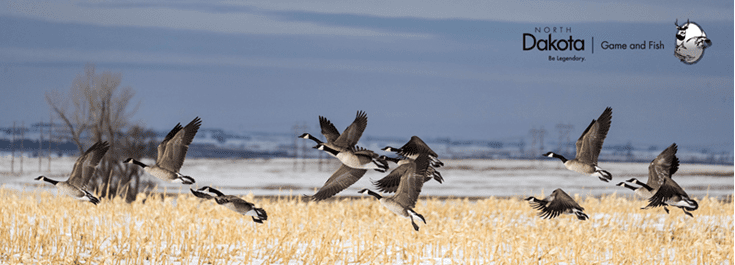

The North Dakota Game and Fish Department’s annual midwinter waterfowl survey in early January was a record breaker.
During the aerial midwinter survey, one of the longest running coordinated migratory bird surveys in North America, biologists counted more than 300,000 Canada geese.
“Our old record was about 222,000 Canada geese, so we blew that out of the water,” said Mike Szymanski, Department migratory game bird management supervisor.
Compared to last year when winter came early and stayed late, there was a lot more open water along the Missouri River System to hold birds. Last winter, for example, Lake Sakakawea iced over on Dec. 18, making it one of the earliest dates for freeze up in recent years.
“We had a really nice December … a lot of areas were almost 10 degrees above average for the entire month of December,” Szymanski said. “There was a lot of open water under nice conditions, with no feeding limitations on the birds. That translated into our wintering waterfowl estimates. Last year, we really didn't need to survey any of Lake Sakakawea because of early freeze up. But this year the lake was open from about the Van Hook Arm down to the dam and the U.S. Highway 83 causeway.”
Interestingly, biologists counted more than 9,000 snow geese during the survey.
“That was kind of surprising. We've always had some snow geese here and there, but most years we have zero,” Szymanski said. “To have sizable numbers like that is pretty interesting.”
Also, biologists typically see around 5,000 to 10,000 mallards during the survey. During this year’s midwinter count, the tally jumped to 43,000 birds.
While that sounds like a sizeable increase, Szymanski said the number of mallards tallied, in the grand scheme of things, was simply a drop in the bucket when it comes to continental populations.
“We really don’t have that many mallards in North Dakota during the midwinter survey,” he said.
All states in the Central Flyway participate in the midwinter survey during the same time frame to reduce the possibility of counting birds more than once.
“What we learn in the surveys is used primarily to estimate some of the species that we don't have very good breeding count estimates for, especially arctic nesting birds,” Szymanski said. “It also helps paint a picture of waterfowl distributions, kind of in the middle of hunting season for some of the wintering states. And also changes in wintering distributions over time.”